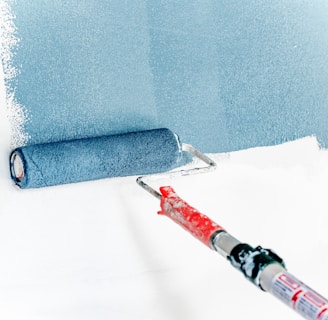Let’s paint safely and responsibly.
Painting your walls is one of the easiest and most satisfying do-it-yourself projects there is and choosing the proper paint that is safe and environmentally friendly can get pretty complicated.
Bianca Ferrando
7/7/20233 min read


Painting your walls is one of the easiest and most satisfying do-it-yourself projects there is and choosing the proper paint that is safe and environmentally friendly can get pretty complicated. We all know that low VOCs and 0 VOCs are a good thing, but what do those really mean exactly?
VOC stands for “volatile organic compound” and refers to a class of chemical that will evaporate quickly at room temperature, and can keep on evaporating for weeks depending on the type of paint. Inhaling VOCs can cause health problems like nausea, dizziness, irritation of the eyes and the respiratory tract, along with heart, lung, or kidney damage, and even cancer (please read more about it here).
There are a lot of paints that claim to have low VOCs or 0 VOCs so how can we be sure that we can trust those claims? There is a non-profit organization called Greenguard Environmental Institute, recognized worldwide, that aims to protect human health by improving indoor air quality. This organization performs industry-independent scientific testing and monitors chemical emissions. Upon testing, if products meet UL Environment’s stringent emissions standards they may qualify for certification. If you look for Greenguard Certified products you can trust it will be safer and more environmentally friendly.
Almost every paint producer has at least one paint in their selection that meets Greenguard Gold certification standards, so you will be sure to be able to find one which price fits in your budget.
4 things you can do to paint more responsibly
· Take time to make the proper calculations and buy an appropriate amount of paint to avoid over-buying. This will reduce the amount of left over paint and waste you will have to deal with after your project is completed.
· Re-use your rollers as many times as possible. If your planning to do multiple coats of the same color, simply wrap the roller in plastic using a plastic bag or cling wrap (there are biodegradable versions of both, but you will have to clean the paint off of them before they will actually biodegrade as intended). I have used this method before and it works nicely if the roller is sealed from evaporation properly, and it also works to plastic-seal the paint try to reuse later. If you intend to paint with another color, you will have to clean your rollers before you can start with the new paint. Here is a great article that explains in details how to responsibly take care of your paint tools.
· Cover your floors with any old fabric items like clothing, blankets or rugs, and then save them for the next project. You also have the option of buying a dedicated fabric floor cover if you are planning for several paint project in your house. Fabric is easier to use and manage than the very thin plastic sheets too.
· Paint early in the day, so that you can leave the windows open for a long time to air out the room before closing for the night.
How to handle paint cans after you are done with your home project.
Every time I complete a re-paint home project I usually keep the paint for a number of months and even years just in case. These cans will need to be disposed of at some point though, so how are they regulated and what options are out there to get rid of old paint cans?
Paint is typically a flammable compound. and is classified as hazardous waste unless is 100% dry in the can. There are a number of safe options available to “get rid” of the paint cans that have been sitting in your storage room for the past year.
· A new home project that can make use of the remaining paint without having to buy any additional material or tool. Murals and accent walls are a great way to use left over paint.
· Paint recycle facilities are available often near you. The paint must be in its original container and sealed properly. They often have useful tips on their website on how to make the most out of your paint and reduce paint waste.
Paint drop-off facilities are also an option often county or city run. These programs will dispose of the paint rather than recycling.
